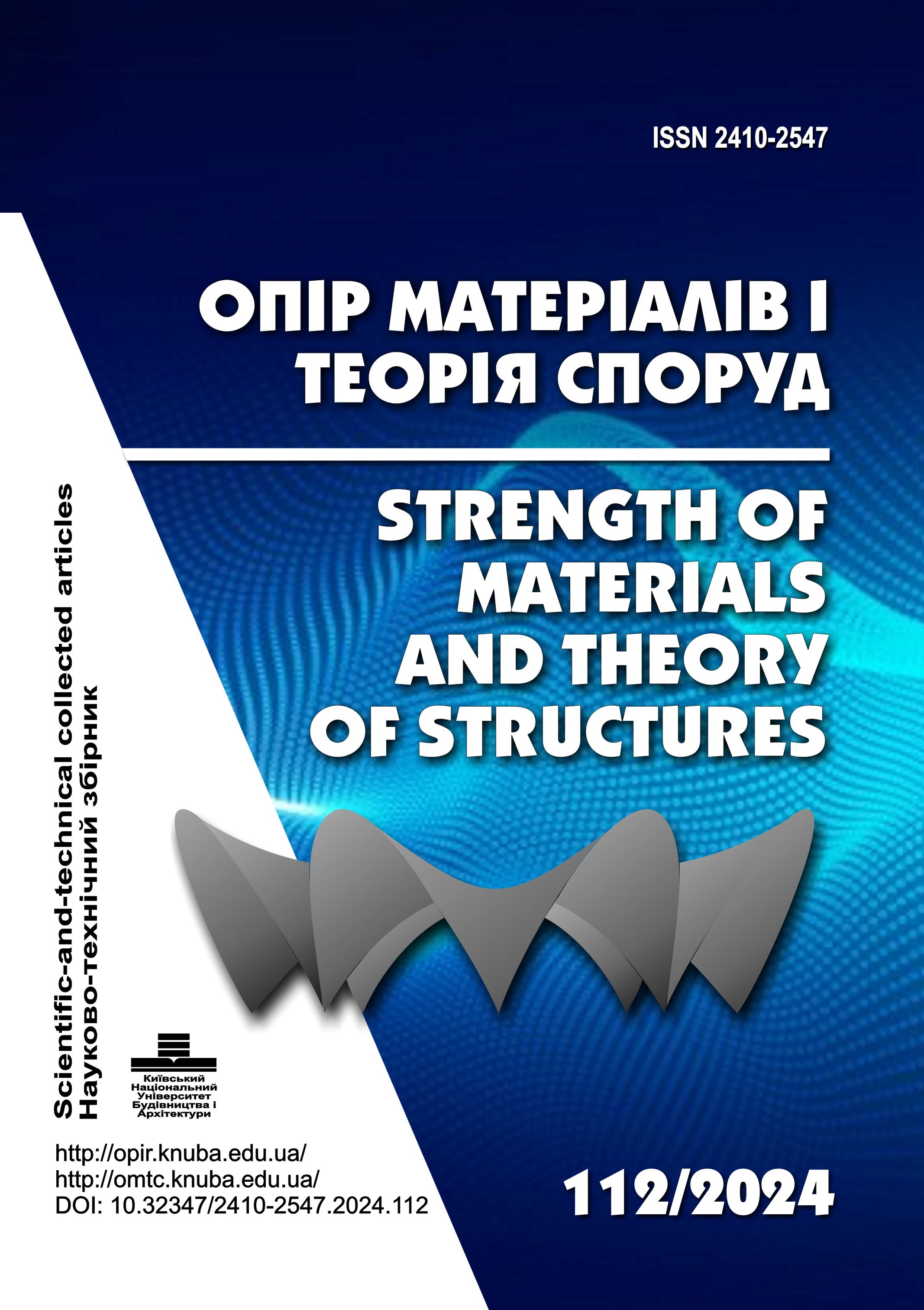Stress state analysis of a cylindrical tank with water of an under water sports palace
DOI:
https://doi.org/10.32347/2410-2547.2024.112.316-326Keywords:
analysis, stress state, cylindrical tank, sports facility, shell, calculation, moment theoryAbstract
The paper analyzes the stress state of a cylindrical tank, which is one of the main structural elements of a sports facility - an underwater sports palace. In the calculation of the cylindrical shell of the tank of constant thickness, the moment theory was used. The reservoir is, in fact, a swimming pool for conducting training sessions on underwater swimming in fins, diving, diving, is considered fixed in its base and filled with liquid (water of a special composition, homogeneous in depth, with a given specific gravity). It is known that integration of the calculation equations of the moment theory (of circular cylindrical shells), namely: a) differential equations of equilibrium; b) equations of deformations; c) equations of forces attributed to the unit length of the coordinate line (tangential forces, bending moments), is a complex mathematical problem associated with solving a system of partial differential equations with variable coefficients. Only the calculation of the curve of a cylindrical shell ultimately leads to a system of differential equations with constant coefficients. Under the assumption of significant depth of the tank compared to the thickness of its walls and the value of the radius of the cylinder base (which allows us to consider it as infinitely long), displacements and forces (tangential and transverse), bending moments are analytically found. The locations of the cylinder surface points, in which the indicated forces and moments acquire maximum values, have been determined; sketches of their diagrams, determining the character of change of these physical quantities (parameters) along the height of the tank, have been given.
The results obtained in the work can be further used to clarify and improve engineering methods of calculation of structural elements of sports facilities of this type, both at the stages of their design and in the modes of real operation in order to prevent situations associated with the loss of their strength and stability.
References
Rekach V.H. Rukovodstvo k reshenyiu zadach prykladnoi teoryy upruhosty. (A guide to solving problems in applied elasticity theory). - M: Vysshaia shkola, 1984. 287 s.
Holdenveizer A.L. Teoryia upruhykh tonkykh obolochek. (Theory of elastic thin shells). – M., 1953. 320 s. {
Geckeler I.W. Forschungsarbeiten. – Berlin, 1926. №276.
Vlasov V.Z. Novyi praktycheskyi metod raschota skladchatykh pokrityi y obolochek. (A new practical method for calculating folded coverings of shells). Stroytelnaia promyshlennost. 1932. №11, 12.
Finsterwalder U. Die Theorie der zylindrischen Schalengewölbe Sistem — Zeiss—Dywidag u ihre Anwendung auf die Grossmarkthalle Budapest. Int. Vereinig Brucken — U. Hochball, Abh. 1, 1932; Ing. Arch. 1933. Bd. 4. s. 43.
Tymoshenko S.P., Voinovskyi-Kryher S. Plastynky y obolochky. (Plates and shells). – M., 1963. 420 s.
Liav A. Matematycheskaia teoryia upruhosty. (Mathematical theory of elasticity). – M. – L., 1935. 360 s.
Rekach V.H. Rukovodstvo k reshenyiu zadach po teoryy upruhosty. (A guide to solving problems in elasticity theory). – M.: Nauka, 1977. 220 s.
Prokopov V.K. Ravnovesye upruhoho osesymmetrychnoho nahruzhennoho tolstostennoho tsylyndra. (Equilibrium of an elastic ax symmetric loaded thick-walled cylinder). Prykladnaia matematyka y mekhanyka. 1949. T. XIII, Vyp.2. P. 123-128.
Hryhorenko Ya.M., Molchenko L.V. Osnovy teorii plastyn ta obolonok z elementamy mahnitopruzhnosti. (Fundamentals of the theory of plates and shells with elements of magnetoelasticity). – K.: Vydavnycho-polihrafichnyi tsentr «Kyivskyi universytet», 2009. 403 s.
Hryhorenko Ya.M., Vlaikov H.H., Hryhorenko A.Ia. Chyslenno-analytycheskoe reshenye zadach mekhanyky obolochek na osnove razlychnykh modelei. (Numerical and analytical solution of shell mechanics problems based on various models). – K., 2006. 280 s.
Bernakevych I.Ie., Vahin P.P., Kozii I.Ia., Kharchenko V.M. Analiz zadachi stiikosti tonkykh obolonok, podatlyvykh do zsuvu ta stysnennia. (Analysis of the problem of stability of thin shells that are susceptible to shear and constraint). Matematychni metody ta fizyko-mekhanichni polia. 2016. T.59, №4. S. 91–96.
Kushnir R.M., Nykolyshyn M.M., Osadchuk V.A. Pruzhnyi ta pruzhno-plastychnyi hranychnyi stan obolonok z defektamy. (Elastic and elastic-plastic boundary state of shells with defects). – Lviv: Spolom, 2003. 320 s.
Shutenko L.M., Pustovoitov V.P., Zasiadko M.A. Mekhanika sporud. (Mechanics of structures). – Kharkiv: KhDAMH, 2001. 234 s.
Huliaev V.Y., Bazhenov V.A., Lyzunov P.P. Neklassycheskaia teoryia obolochek y ee prylozhenye k reshenyiu ynzhenernykh zadach. (Non-classical theory of shells in its application to solving engineering problems). – Lvov: Vyshcha shkola, 1978. 192 s.
Hryhorenko Ya.M., Vasylenko A.T. Teoryia obolochek peremennoi zhostkosty. (Theory of shells of variable stiffness). – Kyiv: Naukova dumka, 1981. 544 s.
Havrylenko H.D., Sytnyk A.S., Matsner V.Y. Ob otsenke nyzhnykh predelov krytycheskykh nahruzok tsylyndrycheskykh obolochek. (On assessing the lower limits of critical loads of cylindrical shells). Prykladnaia mekhanyka. 2006. Tom. 42, № 10. S. 78-85.
Vanyn H.A. Kontsentratsyia napriazhenyi v momentnoi teoryy. (Stress concentration in moment theory). Prykladnaia mekhanyka. 2007. T. 43. №1. S. 66-76.
Dudyk M.V., Dikhtiarenko Yu.V. Suchasni metody teorii pruzhnosti. (Modern methods of elasticity theory). – Uman: PP «Zhovtyi», 2015. 108 s.
Orynyak I., Bai Y. Coupled approximate long and short solutions versus exact Navier and Galerkin ones for cylindrical shell under radial load. Thin-Walled Structures. 2022. V. 170. 108536. P. 145-150.
Downloads
Published
Issue
Section
License

This work is licensed under a Creative Commons Attribution 4.0 International License.
Authors retain copyright and grant the journal right of first publication with the work simultaneously licensed under a Creative Commons Attribution License that allows others to share the work with an acknowledgement of the work's authorship and initial publication in this journal.

